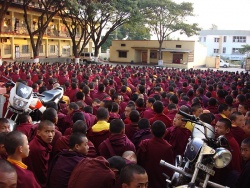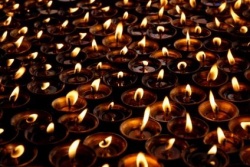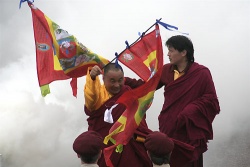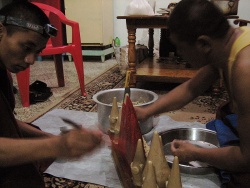All Tibetans Are Believers
TIBET boasts magnificent monasteries. Pious followers of Buddhism crossing the spectrum of occupations and social status, wearing both Western and traditional Tibetan attire, arrive in droves, all repeating the same ritual of bringing their heels together, putting their palms together over their head, kneeling and prostrating on the ground. Their murmured prayers mingle with the intoxicating prayers mingle with the intoxicating scent of burning azalea twigs, which hang over the lanes leading to the temple and the front square.
A visitor to Tibet who joins the procession of believers often finds himself carried away by the religious atmosphere; nothing on earth really seems to matter. Then he remembers the firm ground under his feet and feels a close affinity for his Tibetan sisters and brothers around him. He breathes the same air with them and shares with them happiness and the common struggle to make a better life.
Today, after 20 years, the Tibetans are enjoying better lives and visualizing a bright future. They are again able to interpret the purpose of life with doctrines of their ancient religion.
Buddhism spread to Tibet in the 7th century. Later, Tibetan Buddhism, or Lamaism, spread into Tibetan communities in Sichuan, Gansu, Qinghai, and Yunnan provinces, as well as Mongolia. In the 13th century, Kublai Khan, the first emperor of the Yuan Dynasty, appointed a governor to Tibet in charge of secular and ecclesiastical affairs. Thus began the combined rule of the aristocrats and high priests over Tibet. Lamaism became the central focus of the local government. Between 1368 and 1911, the Ming and Qing governments gave full support to the Tibetan ruling classes. By order of the Qing emperor, the Dalai Lama became Tibet's absolute ruler.
Every Tibetan is a believer. Buddhism plays an important role in everyday life. Our guide Azu Ma told me that Tibetans believe in fate. As a result, they perform good deeds and chant the scriptures in hope of attaining a better next life. During festivals, they keep the butter-oil lamp bright next to the religious niche found in every Tibet household. Anyone who leaves home on a journey carries an image of Buddha or an amulet for exorcism in a pouch hung round her or his neck. In cases of minor disease and misfortune ,Tibetans recite sutras as a means of overcoming hardship. In a case of more sever hardship that results from both natural and man-made calamities, however, they solicit the help of a lama. Historically even major political and military moves were the result of soliciting divine guidance.
Tibetan tradition considers family shackles, and wealth and social position illusion. These institutions are ever-changing and bring only disappointment. In one monastery we saw an old woman singing instead of chanting while making the rounds of the scripture hall. The old woman was exhorting people to discard the trappings of secular life and work for the Buddha. She believes in reincarnation and the continuation of life beyond death. Life is a trial which will hopefully end in a better next life.
We visited the Ganden Lamasery, the largest of the three great lamaseries. Built along a mountain slope, the gold-topped and red-walled temple once housed 3,330 monks. It features more than 90 stupas of celebrated monks including that of Tsong Kha Pa. I learned of the recent history of Tibetan Buddhism. At Ganden I spoke with Lobum Qangbawangmu, a 64 year-oul head nun of the Camgu Nunmery. Dshe told me of the particular problems that women face in the Tibetan religion. Women are not allowed to enter a number of scripture halls for fear they might offend the Buddha and bring disaster to the people.
Only men are entitled to become lamas, the most respected monks who guide people in Buddhism. In the past, a large portion of the female population entered the religious life as nuns, even though they were not permitted to become lamas.
I also learned from Lobum about the traditional Buddhist festivals when lamas from Drepung, Ganden and Sera monasteries got together in the Jokhang Temple and recite scriptures for 21 days. This activity was financed by the local government. The lamas received alms from the congregation and the local government. But the nuns were excluded from the activity. They were also not allowed to take part in any political or military activities.
Lobum came to the nunnery at the age of 15. She studied hard and when she was 25 years old, she became the leading chanter. Three years later, she was an instructor in her nunnery. In 1959, after the liberation of Tibet, Lobum Qangbawangmu and other nuns were allowed to contribute equally in the Lamaist hierarchy. In 1960, she was elected standing council member of the China Buddhist Association Tibet branch as a representative of women in the religious community. She became an important political figure.
In 1981, Lobum cane to work in the religious affairs department of the Tibet Autonomous Region as head of the second division. She was in charge of the restoration of the monasteries and religious life. In 1982, she was elected member of the Tibet People's Political Consultative Conference, and later she was on its standing committee.
In response to Lobum's invitation, we visited her Camgu nunnery. Camgu stands by the Lhasa River. According to legend, this is the place where King Songtsan Gambo sat and meditated to check the rising river. Later, followers of Tsong Kha Pa, founder of the Yellow Sect of Buddhism, built the nunnery in the king's honor. Upon our arrival, we met Dainzin Sangmo, head of the nunnery and also a council member of the Tibet Buddhist Association. Nine nuns live at Camgu. On the 8th, 10th, 25th and 30th of every month on the Tibetan calendar, they assemble to recite scriptures or celebrate with alms given by the believers.
A long-term contract with the Lhasa Carpet Factory provides raw wool for the nuns to spin into yarn. Lobum praised Camgu for its self-supporting policy.
Over the past two years, a few of the nuns reached the retiring age of 55. The government provides pensions so the women may retire. The retirement age for a monk is 60.
People are busily working to restore lamaseries and temples. In preparation for the normalization of religious life in Tibet in 1980, people began on their own initiative to make repairs. Volunteer workers arrived by truck, tractor, and oxcart to Ganden Lamasery. The pilgrims offered money and food toward the restoration project. While visiting one temple, I took out a few bills and placed them on a silver platter. The monk who stood behind the platter put his hands together before him in a sign of gratitude and sprinkled a few drops of water on my forehead in a gesture to give me good luck.
Inspired by the recent policies toward religion a former nun who had returned to secular life came and asked the nunnery to accept her daughter. Drecruits are also being taken in Drepung, Ganden, Sera and other large monasteries.
A new Buddhist Seminary has opened under the sponsorship of the Drepung Lamasery. The Seminary is the primary institution for training Buddhist scholars in Tibet.
Sending daughters and sons to serve Buddha is a means for parents to express gratitude to Buddha for answered prayers.
At the top of Jokang Lamasery, we met with some little lamas flying kites. Their newly shaven pates were blue with short hair. They were still reluctant to part hair. They were still reluctant to part with their worldly life. A woman approached them with a parcel in her hands. The monk who was accompanying her touched the head of a boy whose eyes brightened at the sight of the woman, and he ran over to her. The mother was not excited though. She looked at her son and smiled.
I thought of asking the woman why she had sent her little son to the monastery. "To fulfil a vow," an old monk answered my question for her. "What vow? Has one of her family become ill? Or, is there a misfortune in the house?" I hoped my questions were not out of line. "No. We now have freedom in religious belief. We hope that the new policies will not change but remain the same forever." The alms received by the lamasaries and nunneries over the past five years almost equal the amounts received during previous days when religious activities were at their height.



